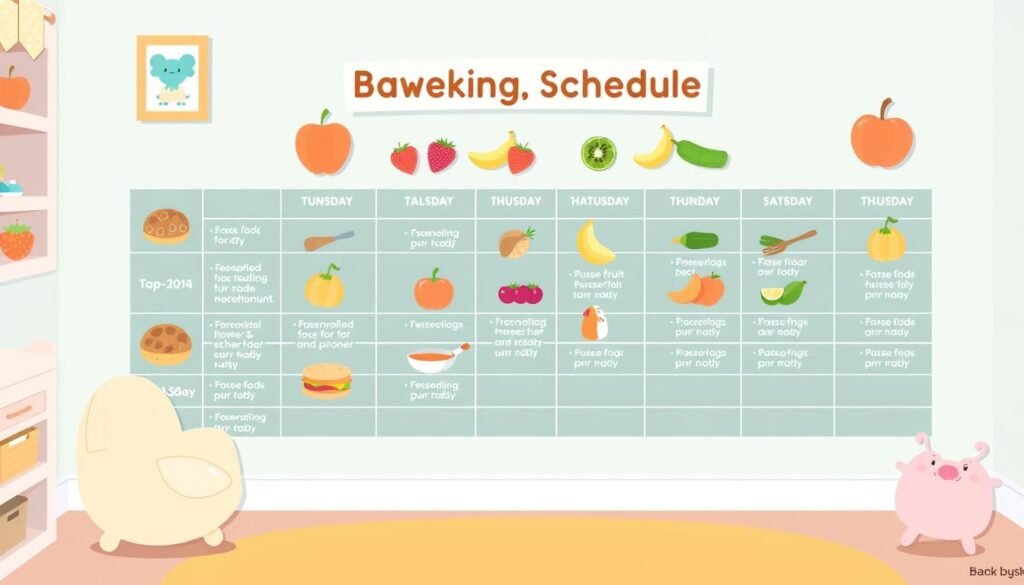At 5 months, your baby is growing fast. You might wonder how much they should eat. Most 5-month-olds need to eat every 3-4 hours, which is 4-6 times a day. They should drink about 22-28 ounces of formula or breast milk each day.
It’s best to feed them when they want to, so watch for signs like fist-to-mouth movements. They’re not ready for solid foods yet. The American Academy of Pediatrics says to stick with breast milk or formula until they’re 6 months old.
Even though they might still need 1-2 nighttime feedings, their eating schedule should be set by now. Paying attention to their hunger cues helps. This way, you make sure they get enough to eat for their growth.
Understanding Your 5-Month-Old’s Nutritional Needs
Your 5-month-old baby is growing fast. It’s important to make sure they get all the nutrients they need. These nutrients help them grow and reach new milestones.
Daily Nutritional Requirements
At this age, babies usually grow 1 1/4 pounds and 0.8 inches every month. They need 22-28 ounces of milk or formula each day. This amount gives them the right amount of calories, about 90-120 calories per kg of body weight.
Caloric Intake Guidelines
The CDC says 5-month-old babies should eat every 2-3 hours. This means they need 4-6 ounces of milk or formula at each feeding.
Essential Nutrients for Development
Breast milk or formula is full of important nutrients for 5-month-old babies. These include proteins, fats, carbs, vitamins, and minerals. Nutrients like iron, calcium, and vitamin C are especially key during this time of fast growth.
When feeding your 5-month-old, pay attention to their hunger signs. A balanced diet and advice from your pediatrician will help your baby get the nutrients they need to grow strong.
5 month old baby feeding schedule: Sample Daily Routine
As your 5-month-old baby grows, a consistent feeding routine is key. It ensures they get the nutrients they need. Here’s a sample daily schedule for a 5-month-old:
- 7:00 AM: Wake-up feed with breast milk or formula
- 10:30 AM: Mid-morning feed with breast milk or formula
- 2:15 PM: Early afternoon feed with breast milk or formula
- 5:15 PM: Late afternoon feed with breast milk or formula
- 7:00 PM: Bedtime feed with breast milk or formula
This schedule is just a guide. It should fit your baby’s needs and your family’s lifestyle. Make sure to offer breast milk or formula at each feeding. Each session should last about 15-20 minutes for breastfeeding or 6-8 ounces for formula.
| Age | Feeding Routine | Milk/Formula Intake |
|---|---|---|
| 3-5 months | 4-5 feedings per day | 24-32 fl oz per day |
| 6-7 months | 4-5 feedings per day, with introduction of 1-2 solid meals | 24-32 fl oz per day |
| 8-9 months | 4-5 feedings per day, with 2 solid meals | 24-32 fl oz per day |
| 10-11 months | 3-4 feedings per day, with 3 solid meals | 20-30 fl oz per day |
This is just a general guideline. Your baby’s feeding routine and milk feeding needs might be different. Always talk to your pediatrician if you have any concerns about your baby’s baby schedule or growth.

Breast Milk and Formula Requirements at 5 Months
When your baby is 5 months old, their eating habits and nutritional needs change. It’s important to know how much milk they need, whether you’re breastfeeding or using formula. This ensures they get the nutrients they need to grow strong.
Breast Milk Feeding Patterns
At 5 months, breastfed babies nurse 5-6 times a day. Each session lasts 10-20 minutes per breast. This helps them get the right mix of milk. During growth spurts, they might nurse more often.
Formula Feeding Guidelines
Formula-fed babies at 5 months drink 24-32 ounces of formula daily. They do this in 6-8 feedings. Each feeding is 6-8 ounces, but needs can vary.
Signs of Adequate Milk Intake
- 4-6 wet diapers per day
- Consistent weight gain within the normal range
- General contentment after feedings
These signs show your baby is getting enough milk. If you’re worried about their eating, talk to your pediatrician.
Signs of Hunger and Fullness in Your Baby
As a new parent, it’s key to know your baby’s hunger and fullness signs. These cues help ensure your baby gets the right amount of food. Let’s look at the common signs of hunger and fullness in a 5-month-old.
Hunger Cues
- Increased alertness and fussiness
- Lip-smacking or sucking motions
- Putting their hands to their mouth
- The rooting reflex, where your baby turns their head and opens their mouth in search of the breast or bottle
Fullness Cues
- Turning away from the breast or bottle
- Slowing down or pausing during feedings
- Becoming easily distracted or falling asleep
It’s vital to listen to these cues instead of sticking to a strict feeding schedule. Every baby is different, and their needs change daily. By paying attention to your baby’s hunger and fullness signs, you can make sure they’re getting what they need to grow strong.
| Hunger Cues | Fullness Cues |
|---|---|
| Increased alertness and fussiness | Turning away from the breast or bottle |
| Lip-smacking or sucking motions | Slowing down or pausing during feedings |
| Putting their hands to their mouth | Becoming easily distracted or falling asleep |
| The rooting reflex |
Listening to your baby’s hunger and fullness cues is essential for their growth. By paying attention to these signs, you can make sure your baby is getting the nourishment they need to thrive.
“Feeding your baby should be a calm, relaxed experience for both of you. Trust your instincts and respond to your baby’s cues to create a positive feeding environment.”
Common Feeding Challenges at 5 Months
When your baby hits 5 months, you might face some feeding hurdles. These can include resistance to feeding and dealing with growth spurts. It’s key to be ready and have plans to meet your baby’s nutritional needs.
Dealing with Feeding Resistance
Feeding resistance is common at this age, often due to distractions or teething discomfort. To tackle this, make mealtime a calm, quiet spot. Avoid too much noise or stimulation. Try offering smaller, more frequent meals to keep your baby engaged.
Managing Growth Spurts
Growth spurts can make your 5-month-old hungrier and need more feedings. Listen to your baby’s hunger cues and feed them more often. Remember, these spurts are short-lived, and feeding times will get back to normal soon.
Addressing Feeding Issues
Some 5-month-olds might face feeding problems like reflux or gas. If your baby has ongoing feeding troubles, talk to your pediatrician. They can find the cause and suggest the best ways to feed your baby.
By tackling these common feeding challenges, you can help your 5-month-old get the nutrients they need. This supports their healthy growth and development.

Night Feeding Patterns and Sleep Schedule
As your 5-month-old baby grows, their sleep and feeding needs change. Many babies at this age sleep longer at night but still need 1-2 night feedings. If they eat well during the day and gain weight, they might drop those night feeds.
A typical 5-month-old sleeps 10-12 hours at night and naps 2.5-3.5 hours during the day. Bedtime is usually between 7:00 and 8:00 PM. The third nap is shorter, about 30-45 minutes, to avoid overtiredness.
Every baby is unique, and their night feeding and sleep needs vary. It’s crucial to work with your pediatrician to find a feeding routine and sleep schedule that suits your baby.
“Sleep training is associated with happier babies and parents, as per research.”
Transitioning your 5-month-old off night feeds should be done gradually and with your doctor’s advice. With patience and consistency, you can help your baby develop healthy night feeding and sleep habits for your family.

| Sleep Metric | 5-Month-Old Recommendation |
|---|---|
| Total Daily Sleep | 14.5 hours |
| Nighttime Sleep | 10-12 hours |
| Daytime Naps | 3-4 naps, 2.5-3.5 hours total |
| Bedtime | 7:00 PM – 8:00 PM |
| Awake Time Before Bed | 2.5-3 hours |
| Night Feedings | 1-2 feeds |
Preparing for the Transition to Solid Foods
When your baby hits the 6-month mark, it’s time to introduce solid foods. Most babies are ready for their first tastes around this age. But, some might show readiness a bit earlier. Look for signs like sitting up well, not pushing food out with their tongue, and showing interest in your food.
Signs of Solid Food Readiness
- Sitting up with support
- Good head and neck control
- Loss of the tongue-thrust reflex
- Interest in the food you’re eating
First Foods to Consider
Start with iron-fortified cereals, pureed veggies and fruits, and mashed bananas or avocados. Begin with 1-2 tablespoons twice a day, after breast milk or formula. Introduce new foods one at a time, waiting 3-5 days to check for any reactions.
| Recommended First Foods | Feeding Amounts |
|---|---|
| Iron-fortified single-grain cereals | 1-2 tablespoons, twice daily |
| Pureed vegetables and fruits | 1-2 tablespoons, twice daily |
| Mashed bananas or avocados | 1-2 tablespoons, twice daily |
It might take 10-12 tries for your baby to like a new food. So, be patient and offer many healthy options. With time, your baby will enjoy a variety of foods for a lifetime!
Safe Feeding Practices and Positioning
Keeping your baby safe and comfortable during meals is key. When bottle feeding, hold your baby up a bit and tilt the bottle to avoid air. Never prop the bottle, as it can cause choking and ear infections.
For breastfeeding, make sure your baby has a good latch to avoid pain and ensure milk flow. Try different holds like the cradle or side-lying to find what works best. Always burp your baby after feeding to help with gas and spit-up.
- Hold your baby close during feedings to promote bonding and safety.
- Avoid putting babies to bed with bottles, as this can lead to tooth decay and other health issues.
- Introduce new foods one at a time and watch for any signs of allergic reactions.
- Avoid foods that may cause choking, such as grapes, hot dogs, and hard candies.
By following these safe feeding practices and paying attention to your baby’s positioning, you can ensure your little one enjoys mealtimes and stays healthy. Remember, every baby is unique, so be patient and adjust your approach as needed to find what works best for your family.
“Proper feeding positioning and safety practices are essential for your baby’s well-being and your peace of mind.”
Tracking Growth and Development Milestones
Watching your 5-month-old baby grow is key. You should track their weight, length, and how they’re developing. At this age, babies usually double their birth weight. Boys weigh about 16 pounds 9 ounces, and girls weigh 15 pounds 3 ounces on average.
Regular visits to the pediatrician are crucial. They help track your baby’s growth and check if they’re hitting important milestones.
Your 5-month-old might start rolling over, get better at hand-eye coordination, and talk more. Good nutrition and care are essential for these milestones. Make sure your baby has enough wet diapers (4-6 per day) and bowel movements to stay hydrated and nourished.
Remember, every baby grows at their own pace. What’s important is their own growth curve, not comparing to others. Celebrate your child’s unique progress and work with your pediatrician on any concerns.
Enjoy the journey of your 5-month-old’s growth and development. Pay attention to their cues, trust your instincts, and cherish every moment as they grow and thrive.
When to Consult Your Pediatrician About Feeding
As a parent, watching your baby’s eating habits and growth is key. If you see signs like poor weight gain, less appetite, or constant vomiting, talk to your pediatrician. They can spot problems and guide you on fixing them.
Keep an eye on your baby’s weight and how they eat. Also, plan to talk about introducing solid foods around 6 months. The American Academy of Pediatrics suggests this age for starting solids. Your pediatrician can advise on the best time and method for your baby.
Regular visits to your pediatrician are vital for tracking your baby’s growth. They can share important advice on nutrition and support. If you’re worried about feeding or have questions, don’t hesitate to ask. Your pediatrician is there to support you and your child.


